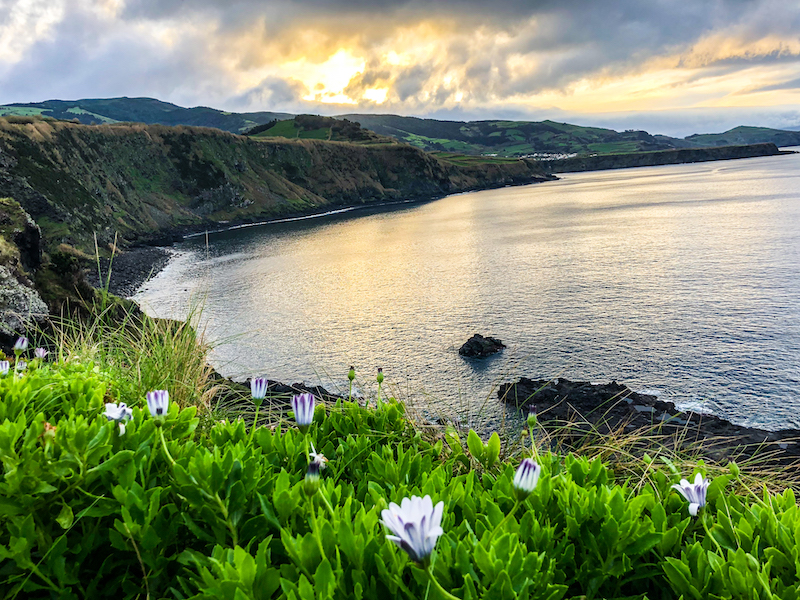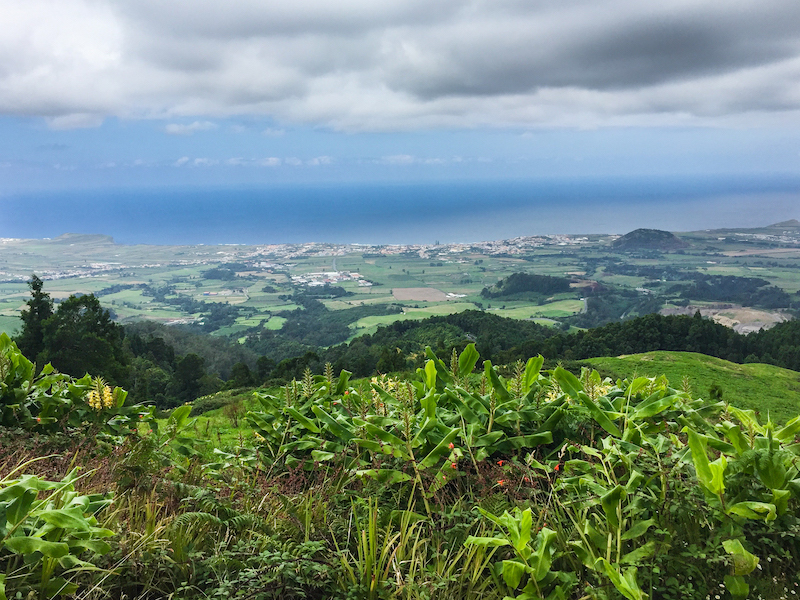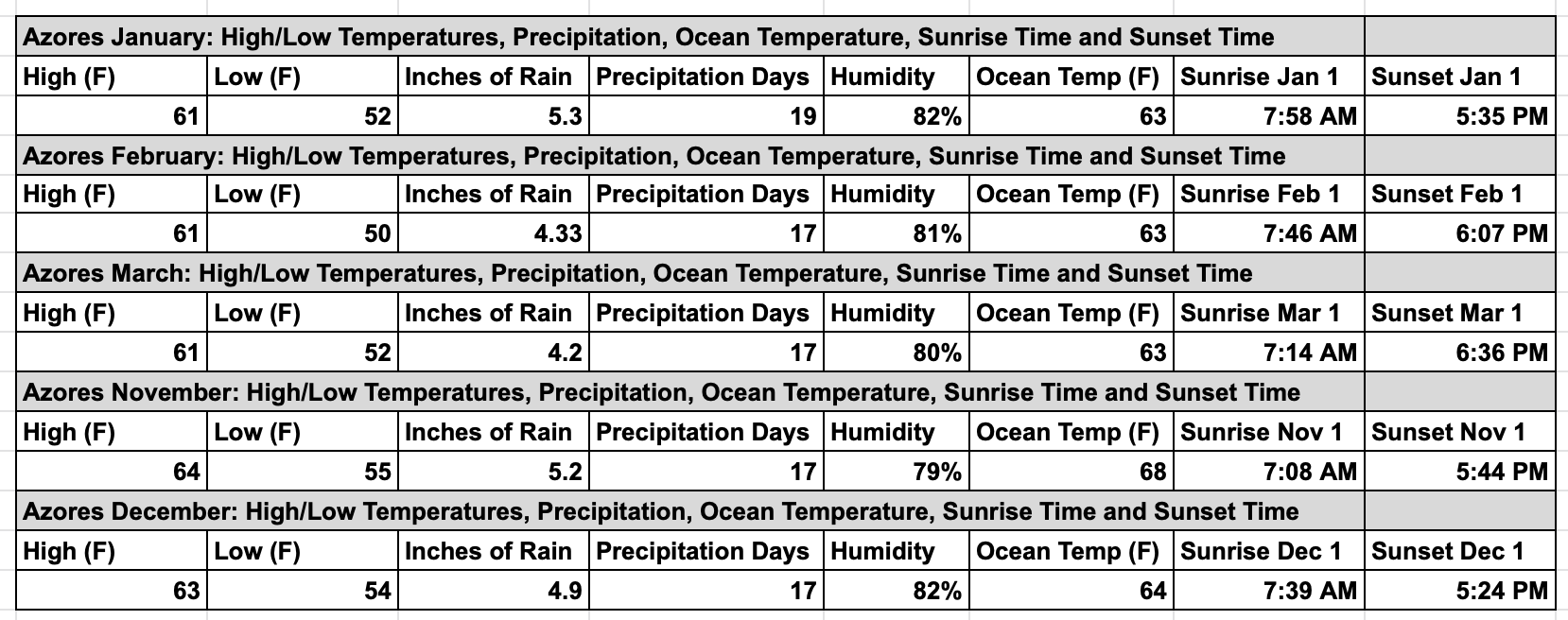Azores weather is both temperate, thanks to the gulf stream, and unpredictable. It’s often said that you can see 4 seasons in a day in the Azores. Read on to find what type of weather you’ll likely find when you visit the Azores, the best Azores weather apps/websites, whether you have to worry about hurricanes, and what to pack.
Note that the statistics are for Sao Miguel Island, which is the biggest and most visited Azores island. The other islands have pretty similar weather. You can learn more on which is the best Azores island to visit.

What Does it Mean to have Four Seasons in a Day in the Azores?
Four seasons in a day means that any day of the year, you can have weather that’s like spring, summer, fall or winter in the Azores. The good news is that Azores weather doesn’t vary a lot, and it’s typically between 50°F to 75°F all year round. The hottest day on record in Ponta Delgada (the biggest city in the Azores) is 84°F and the coldest day is 38°F.
But the humidity is high in the Azores and is typically around 78-82% all year round. In the summer, that means muggy weather when it’s hot. Also, the humidity can make any sunny day feel 10 degrees warmer, so a sunny and humid 65°F day in January can feel about 75°F. Or in the summer, if it’s overcast and windy, and unusually cold day can feel cooler in the Azores. The humidity in the winter brings a dampness that can feel chilly when the sun isn’t out or when you’re inside without heat.
You (Usually) Don’t Need to Worry About Hurricanes in the Azores
Although the Azores occasionally see hurricanes, like Hurricane Lorenzo in 2019, hurricanes typically lose strength on the cold water before they reach the Azores islands. If there are hurricanes in the Azores, they typically come from the south (the Cape Verde area) and almost always reach the Azores islands in September or October.
So, although its temperate, you should be prepared for all seasons whenever you go to the Azores, and even be prepared for all types of weather in one day! It’s lush and green for a reason, so it typically rains a little bit each day. But it rarely rains for extended periods, so you can get out and hike almost every day.
Azores Weather Websites and Apps
Your standard weather apps and websites are good for approximate temps, but Wind Guru is the most accurate for wind, precipitation and cloud cover. You should also us Spot Azores, which is a website that shows live webcams from different locations on the Azores islands. You can also download the Spot Azores IOS App or Android App.
Don’t try to be too regimented on your schedule before you arrive on your Azores adventure; the weather is constantly changing. Also, even though the islands are small, there are microclimates, so the weather can be different on different parts of an island. It’s typically nicer on the coasts than inland. For example, on Sao Miguel, it’s most likely to be cloudy at the highest spots on the island, so Lagoa do Fogo and Sete Cidades.
So, that is why we say in the Travel Honey itinerary, stay as flexible as you can and check the Spot Azores webcam app each morning to decide what to do.

Azores Weather in the Late Fall and Winter: November, December, January, February and March
Azores weather during the late fall and winter is pretty similar, the average highs range between 61°F and 64°F and the average lows are between 50°F and 55°F. February is typically the coldest of these months and November is typically the warmest.
These months are typically the wettest months of the year in the Azores with between 4.2 and 5.3 inches of rain and between 17 and 19 days of precipitation. January is typically the wettest of these months and March is the driest. The humidity in the Azores varies only slightly all year, so it’s between 79-82% during these months.
You should be prepared for rain during these months, but you will rarely find a day where it rains the whole day across an entire island, so you can usually always get out and hike. You can go whale watching during these months, but the excursions are often cancelled because of bad weather or rough seas. The must see crater lakes are also more likely to be fogged in during the late fall and early winter.
If it’s a sunny day, it’s a great time to walk the many beaches, but you’ll rarely get a “beach day” during these months. If you want to brave the ocean, November has the warmest water, and it’s on average 68°F. January, February and March have the coldest ocean temperature when it’s on average 63°F.
Although not great beach weather in the Azores, the late fall and winter are a great time to visit the amazing hot springs on Sao Miguel. We recommend spending a couple days in Furnas on your visit to Sao Miguel to really take advantage.

Azores Weather in the Early Spring and Early Fall: April, May, June and October
The average temperatures and precipitation are a bit more varied in the early spring and early fall, but we’ve still grouped these months together, because you really can get any type of weather during these months.
April and May are on average a bit cooler than June and October. April has an average high of 63°F, May has an average high of 66°F, whereas the average high for June and October is 70°F. So, you have a better chance of getting beach days in June and October in the Azores, but these months usually are cool enough to make the hot springs enjoyable.
October tends to be a little more wet, it has on average 4.5 inches of rain and 16 days of precipitation, whereas April has on average 2.8 inches of rain and 13 days of precipitation, May has 2.2 inches of rain and 12 days of precipitation and June has 1.5 inches of rain and 10 days of precipitation. The humidity in the Azores varies only slightly all year, so it’s between 79-82% during these months.
Of these months, the ocean is warming in the spring and is 63°F in April, 64°F in May and 68°F in June, but it’s the warmest in October at 70°F.

Azores Weather in the Summer: July, August and September
July, August and September are the warmest months in the Azores and the average highs are between 75°F and 77°F and the average lows are between 63°F and 64°F. So September is a great time to visit the Azores if you want warm weather but want to avoid the crowds. Just note that July and August have on average less precipitation than September, so they are the best months to visit the Azores amazing beaches. July has on average 1.3 inches of rain and 9 days of precipitation, August has on average 1.6 inches of rain and 9 days of precipitation, whereas September has on average 3.3 inches of rain and 13 days of precipitation.
The humidity in the Azores varies only slightly all year, but it’s at its lowest average of 79% during July through September. The ocean is the warmest all year during these months, between 72-75°F.
Because the weather is the nicest during these months, you’re more likely to get clear days at the must see crater lakes, Sete Cidades and Lagoa do Fogo (learn all the must sees and hidden gems).

What to Pack When Visiting the Azores
Because Azores weather can be so varied, layers are a great thing to pack whenever you plan to visit the Azores. You should also always bring a rain coat, because it rains a little bit almost every day, and sandals and a bathing suit. In the warmer months, you can use the sandals and bathing suit at the beach, in the winter at the hot springs. The hot springs on Sao Miguel island have iron deposits, so bring a bathing suit you don’t mind turning an orange/yellow/brown color.
In the winter time, you can pack mostly pants, leggings/light pants for hiking and jeans at night for dinner. Bring a few short sleeves for the day that you can layer, because you can work up a sweat if it’s sunny. You’ll want to layer with a long sleeve shirt and either a vest of light jacket, especially if it’s overcast and windy, which often happens at higher elevations.
In the summer, you should pack mostly shorts/short sleeves for the daytime. You can also usually wear shorts/dresses at night, but bring a long sleeve shirt. You can still usually be comfortable wearing jeans at night because it’s cooler without the sun. You should also consider packing at least a pair of pants for during the day, because, as we’ve said above, when it comes to Azores weather, be prepared for all 4 seasons on your visit!
We hope our summary of Azores weather will help you be better prepared for your trip, but if you need more information, check out the best time to visit the Azores, which also covers accommodation rates, how busy it is, flowers blooming, whale watching and Azorean festivals and holidays.